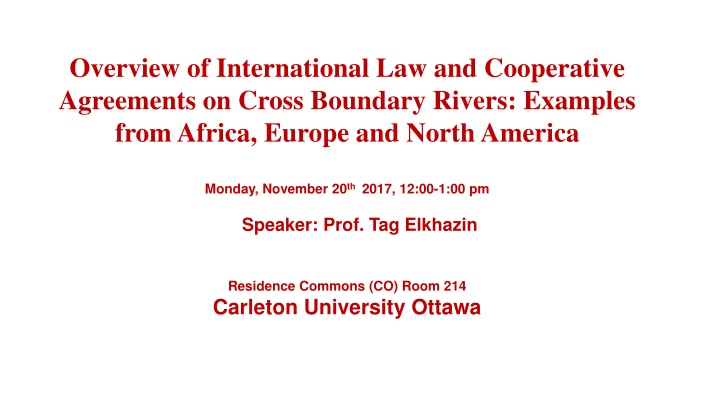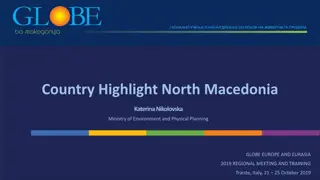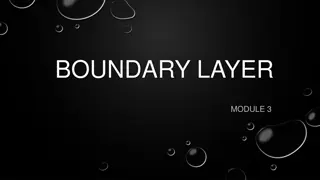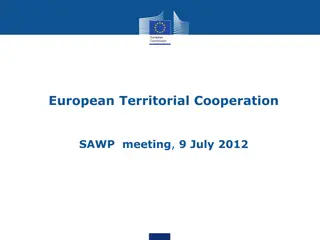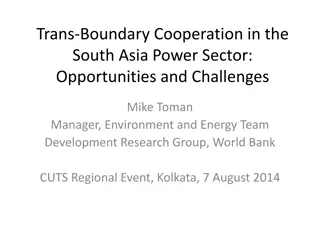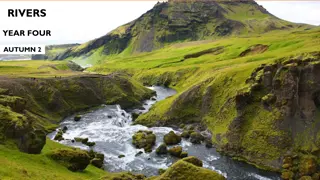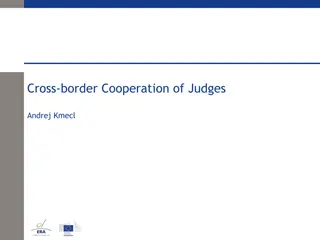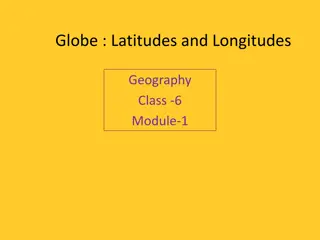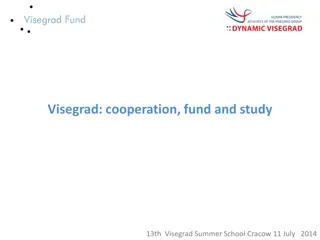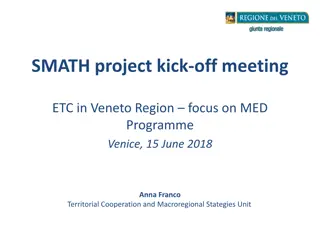International Cooperation on Cross-Boundary Rivers: Perspectives from Around the Globe
Delve into the intricacies of international law and cooperative agreements concerning cross-boundary rivers, explored through examples from Africa, Europe, and North America. The discussion covers various legal frameworks, such as the Helsinki Rules, Berlin Rules, Vienna Convention, and more, highlighting the importance of international cooperation in managing shared water resources.
Download Presentation

Please find below an Image/Link to download the presentation.
The content on the website is provided AS IS for your information and personal use only. It may not be sold, licensed, or shared on other websites without obtaining consent from the author.If you encounter any issues during the download, it is possible that the publisher has removed the file from their server.
You are allowed to download the files provided on this website for personal or commercial use, subject to the condition that they are used lawfully. All files are the property of their respective owners.
The content on the website is provided AS IS for your information and personal use only. It may not be sold, licensed, or shared on other websites without obtaining consent from the author.
E N D
Presentation Transcript
Overview of International Law and Cooperative Agreements on Cross Boundary Rivers: Examples from Africa, Europe and North America Monday, November 20th 2017, 12:00-1:00 pm Speaker: Prof. Tag Elkhazin Residence Commons (CO) Room 214 Carleton University Ottawa
International Law: Navigational Purposes Non-Navigational Purposes. Our topic Components of International Law The Helsinki Rules on the Uses of the Waters of International Rivers 1966.Guidleines. 37 articles. Non-binding Improvement: the Berlin Rules on Water Resources: 2004. 73 articles. Nothing in these Rules affects rights or obligations created by treaty or special custom . General Assembly. 1997. Started in 1970!! 51/229.Convention on the Law of Non-Navigational Uses. 37 articles. Request to harmonise existing agreements to 229. GA: hence non-binding.
Vienna Convention on Succession of States in respect of Treaties 1978 speaks of what happens if a country splits up. (Yugoslavia, South Sudan, Yemen, USSR . Article 6 The present Convention applies only to the effects of a succession of States occurring in conformity with international law and, in particular, the principles of international law embodied in the Charter of the United Nations . Convention on the Protection and use of Transboundary Watercourses and International Lakes done at Helsinki, on 17 March 1992. 28 articles and several annexes. Talks about pollution control. protection and cooperation. Basel Convention on the Control of Transboundary Movements of Hazardous Wastes and Their Disposal. Massive 117 pages. 29 articles. 9 annexes. Massive attached protocol on liability and compensation. March 1989.
Convention relating to the Development of Hydraulic Power Affecting more than one State and Protocol of Signature. 17 countries, 22 articles, Gen ve December 1923. Under The League of Nations . Adopted in Helsinki August 1966. The Law of Transboundary Aquifers. UNGA, January 2009. 19 articles. (Nothing in the present articles obliges a State to provide data or information vital to its national defence or security. Nevertheless, that State shall cooperate in good faith with other States with a view to providing as much information as possible under the circumstances). Very good definitions of Aquifers . Follow up the Great Sahara Aquifer (Chad, Libya, Sudan .) and the Man-Made River piping the Nubian Sandstone Aquifer System. Convention on the Protection and use of Transboundary Watercourses and International Lakes done at Helsinki, March 1992. 28 articles. 4 annexes. . on the environment, economies and well- being of the member countries of the Economic Commission for Europe (ECE)
May 2014 is a day to remember: Vietnam completed the 35 counties needed for a UNGA Agreement to enter into full force and become binding. 1970-1979-2014. 44 Years! Agreement goes into effect on August 17 2014 (90 days). One last Special Agreement : February 1999. Rights and Benefits. Nile Basin Initiative and the second part of our presentation. Work in progress: Will come back.
Agreements that work well: (only a few examples) North America: International Joint Commission (IJC). US and Canada. 1909. 14 articles. Both rivers and lakes: St. Lawrence, Great Lakes, Kootenay, Okanogan, Colombia, St. Mary, Milk, Red River Europe: Convention on the International Commission for the Protection of the Elbe.1991. EEC, Germany and Czech and Slovak Republic. Protection/pollution. 19 articles. EEC Managing. Danube River Protection Convention. June 1994. 31 articles. 5 annexes. Contracting parties: Germany, Hungry, Serbia, Croatia, Austria, Slovakia, Romania, and Bulgaria. 1780 miles Europe s longest. Massive traffic. (Black Sea). ICPR. Bern. 1999 (1963 and 67). Germany, France, Luxemburg, Netherlands, Switzerland. WWI and WWII. Clean now!
Africa: Working well: Convention and statutes relating to the development of the Chad basin. Signed at Fort Lamy, on 22 may 1964. Signatories: Cameroon, Chad, Niger, Nigeria. No UN or other reginal party. Chari River? Lake Chad? 26,000 SQ KM to 1500 SQ KM or 5.8% of size in 60s. (See next slide). Convention relating to the creation of the Gambia River basin development organization signed at Kaolack June 1978. Gambia, Guinea, Senegal. Amended June 1981. Development of the Gambia River Basin . 24 articles. Very clear and robust agreement. Clear levels of authority up to Heads of State and Government.
Convention relating to the creation of the Gambia River basin development organization signed at Kaolack June 1978. Gambia, Guinea, Senegal. Amended June 1981. Development of the Gambia River Basin . 24 articles. Very clear and robust agreement. Clear levels of authority up to Heads of State and Government Kingdom of Lesotho and the Republic of South Africa Mutual Benefits to be derived from the enhancement, conservation and equitable sharing of the water resources of the Senqu/Orange River and its effluents. October 1986. Long 37 pages, 18 articles agreement Agreement between Zimbabwe and Zambia concerning the utilization of the Zambezi River signed at Harare, 28 July 1987. 33 articles and several annexes. Basically of Energy. Kariba Dam, 128 M high. 10 turbines generating 1626 MW and working well since 1959. Victoria Waterfalls 108 M border between Zimbabwe and Zamia.
Did these agreements create political tranquility? Economic interdependence? Prosperity for citizens? Did they or other agreements: Observe the rights of upstream and downstream citizens affected by structures on the waterways? Can we ponder on the 1959 agreement and the crime committed upon the Nubian Population, their 27 villages and 7000 years history submerged? 3 times in 50 years? A different topic!
Outdated: (Small Example) Agreement between Germany and Great Britain respecting the Boundary between British and German Territories from Yola to Lake Chad (Nigeria and Cameroons), signed at London, 19 March 1906. Went to ICJ!!!10. Where the boundary is formed by rivers, the populations on both banks shall have equal rights of navigation and fishing . Bakassi Peninsula and Cross River Case at ICJ. Protocol signed at Kigoma on 5 August 1924, defining the boundary between Tanganyika territory (Now Tanzania) and the Belgian mandated territory of Ruanda-Urundi (all Nile Basin Initiative States Now). Boundaries. [No Q (Flow Rate Q=V(Velocity) x A (Area X-Section) ; or Energy V2 /2G. V Velocity, G Gravity]. The main concern was the boundaries and basic livelihood, not commercial use of water.
The Mystical Nile: Ethiopia, South Sudan, Egypt, Sudan, Kenya, Rwanda, Burundi, Uganda, Kenya, Tanzania, with Eritrea as observer Agreements: 14 agreements (?) between 1891 and 1993. 1891. Anglo Italian. Demarcation of Sphere of Influence 1894. UK and Belgium (Independent State of Congo). Sphere of Influence 1902. Ethiopia, UK and Italy. Frontlines between Sudan, Eritrea and Ethiopia. Heavily used by the ICJ on the Badme Case. 1906 GB and Belgium to modify the 1894 agreement. 1925 UK, Italy: Concession for the construction of dam on Lake Tana (Current GERD). Quashed!+ Railway Line across Ethiopia, Eritrea and Italian Somalia.
Since 1929 MOU and up to 1993, it was condescending attitude by Egypt to all other Nile Source States as if Egypt Owns the Nile!. The Back-Breaker was the maliciously conceived 1959 agreement that only bilaterally, determining that Egypt and Sudan own ALL the Nile Waters. 85 BC M. 54.5 BCM go to Egypt and 18.5 BCM go to Sudanand the other then 8 countries Eat Coal !! Sudan was taken for a ride! Never used more than 12 BCM. Still no Cooperative Agreement. Or is there? The case of a long-drawn struggle between Rights and Benefits NBI Entebbe as a body starts in Feb 22, 1992 as idea . Canada!
Agreement on the Nile Basin Cooperative Framework started soon after establishment of the NBI. To day 2017, ALL clauses of the draft are agreed except 14 (b): b) not to significantly affect the water security of any other Nile Basin State. All countries agreed to this proposal except Egypt and Sudan. To this effect, Egypt proposed that Article 14 (b) should be replaced by the following wording: Not to adversely affect the water security and {current uses} and rights of any Nile Basin State! That takes us back to 1959 and eating coal!!
The Big Bang! Beles (460 MW , 2010) and Ethiopia stunned both Egypt and Sudan. And: GERD (6500 MW, $6.4 bill, largest in Africa and 3rd largest in the world) and Ethiopia regains pride and dignity second time after Adwa and its battle in March 2nd 1896 crushing the Italians! But GERD is another story/conference. It is changing the way the world is looking at and understanding International Law , whatever that may mean!
